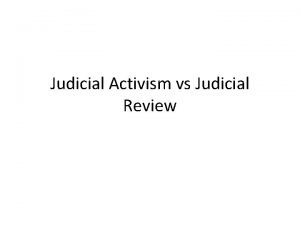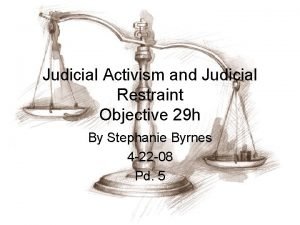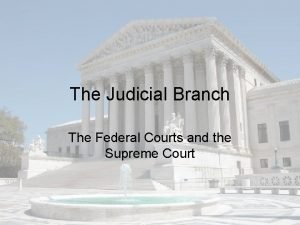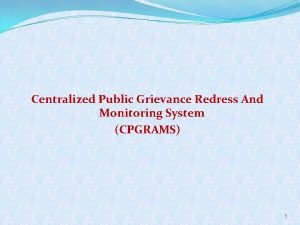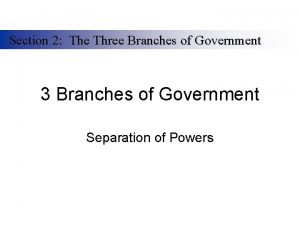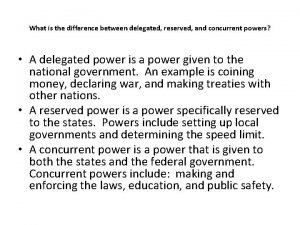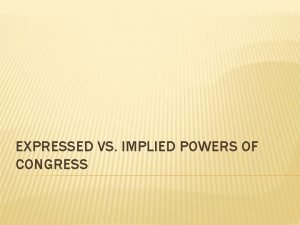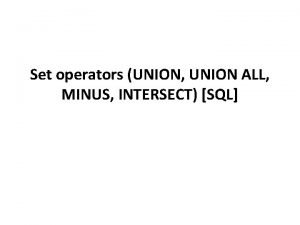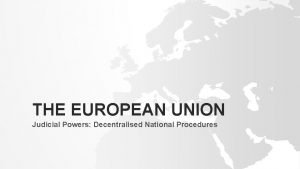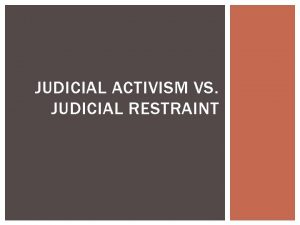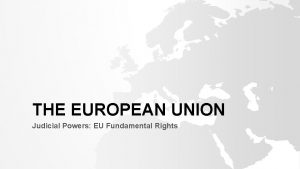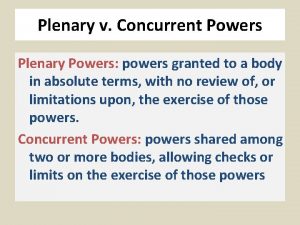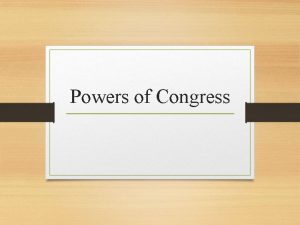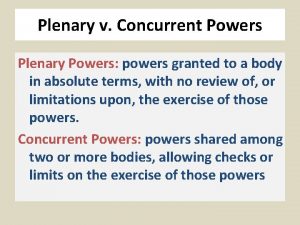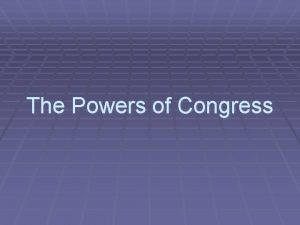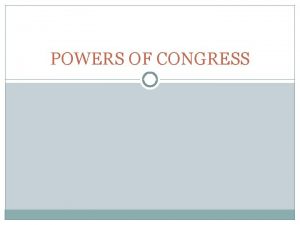THE EUROPEAN UNION Judicial Powers Centralised European Procedures
















- Slides: 16

THE EUROPEAN UNION Judicial Powers; Centralised European Procedures

In this section, we will cover… Reviewable act 1) Judicial powers 6) Preliminary rulings 2) Judicial review or annulment powers Grounds for review and proportionality principle Legal standing Time limitations Against States Against the Union SCHUTZE. EU 5) Enforcement actions 4) Liability actions 3) Indirect review

JUDICIAL POWERS § The State is governed by the rule of law, which reflects that a legal order should provide for judicial mechanisms to review the legality of all governmental acts. § The judiciary has the power to annul legislative or executive acts, the power to remedy public wrongs through governmental liability and the power to adjudicate legal disputes between parties. § The Court of Justice is one of the main mechanisms applied within the EU in order to fulfil these powers in relation to the Union. SCHUTZE. EU

ANNULMENT POWERS; JUDICIAL REVIEW § The most powerful function of the ECJ is to annul an act. § The competence and procedure for judicial review in the EU is established in Article 263 TFEU. § If an action for judicial review is well-founded, the Act in question will be declared void by the ECJ. (Article 264(1) TFEU) § The Union then takes appropriate measures to comply with the judgement of the Court (Article 266 TFEU) and will possibly be required to pay compensation for damage caused by the illegal act. (Article 268 & 340 TFEU) § 4 procedural components are required for a judicial review action; 1. The existence of a reviewable act 2. Legitimate grounds for review 3. Legal standing before the court SCHUTZE. EU 4. Time limitation

1. THE EXISTENCE OF A REVIEWABLE ACT SCHUTZE. EU § Article 264(1) determines whethere can be judicial review. § The Court is entitled to review legislative acts, can review unilateral acts of all Union institutions other than the Court of Auditors. § It cannot judicially review Member States. § The European Treaties cannot be reviewed by the Court. § There can be no judicial review for recommendations or opinions as there have no binding force= no reason to be challenged. (Article 288(5) TFEU) § Acts that are internal to any Union institution are excluded. § Preparatory acts of the Commission or Council cannot be challenged. (IBM v. Commission [1981]) § Wide definition of what can be reviewed as can be seen in ERTA [1971] para 39 -42.

2. LEGITIMATE GROUNDS FOR REVIEW Formal Grounds of Review § A European Act can be challenged if the Union lacked competence to adopt it. (ultra vires review) § Vertical and horizontal application of the principle of conferral allows the Court to protect the institutional balance of powers within the Union. § A Union act can be challenged if it infringes an essential procedural requirement. (ERTA case [1971]) § In relation to misuse of powers, this has been obscurely defined as can be seen in Gutmann vs. Commission [1965]. § Residual ground of review SCHUTZE. EU Article 263(2) TFEU limits judicial review to 4 legitimate grounds; 1. Lack of competence, 2. Infringement of an essential procedural requirement, 3. Infringement of the Treaties or any rule of law relating to their application, 4. Misuse of powers.

THE PROPORTIONALITY PRINCIPLE Proportionality principle exists to protect liberal values. § § Codified via Article 5(4) TEU. § Has the furthest reach of all of the grounds of review. § Tripartite test for proportionality; analysis of suitability, necessity and proportionality in the strict sense is conducted by the Court in order to determine the proportionality of an Union Act. (Fedesa & Others [1990]) § Union has wide margin of appreciation, so the proportionality of an Act will only be tested if the measure is manifestly inappropriate. (Fedesa & Others [1990]) § See Kadi [2008] for a good example of the proportionality test being applied in relation to a Union Act. SCHUTZE. EU

3. LEGAL STANDING BEFORE THE COURT Article 263 TFEU lists 3 categories of applicants. § Privileged applicants who can always bring an action for judicial review (Member States, Parliament, Council & Commission) (Article 263(2) TFEU) § Semi-Privileged applicants who can bring review proceedings for the purpose of protecting their prerogatives. (Court of Auditors, European Central Bank & Committee of Regions)(Article 263(3) TFEU) § Non-Privileged applicants have to demonstrate that the Union Act affects them specifically. (natural/legal persons) (Article 263(4) TFEU) Development of Legal Standing Rome Treaty Formulation (Article 230(4) EC) § 3 forms of decision § Severely restricted the standing of private parties. (direct and individual concern requirement for challenges to a SCHUTZE. EU decision. ) Judicial Amendments § Desertion of the need for a decision. § Codorniu [1994] § Still needed to be direct and individual concern. Direct concern & individual concern § Les Verts [1986] established what direct concern was § Plaumann [1963] established the strict test applied for individual concern. § § Lisbon Treaty Article 263(4) TFEU Plaumann test still applied. Restrictive stance on direct review for private parties. Inuit I [2013]

4. TIME LIMITATIONS § The action for annulment (i. e. use of Art 263 TFEU) must be brought within two months of either: § The publication of the measure (e. g. Regulation or Directive); or § When there was notification to the applicant (e. g. through a letter or a notice); This Photo by Unknown Author is licensed under CC BY SCHUTZE. EU

INDIRECT REVIEW Plea of Illegality (Article 277 TFEU) § Collateral review § Inuit II [2013] § Bypasses two month time limit under Article 263 TFEU & allows individuals the opportunity to challenge legislative acts of regulatory acts that require further implementation. (Simmenthal [1979 para 37 & 41) SCHUTZE. EU Preliminary Rulings (Article 267 TFEU) § Complementary review (Les Verts [1986]) § Challenge legality of Union Acts in national courts. § Indirect review via Article 267 over direct review under Article 263? § Indirect review can be brought against any union act, on any grounds and can be launched by anyone at any time. § Disadvantages to this form of review are; national court has to have jurisdiction, applicant may need to breach EU law prior to review, individual applicants have no right to demand the review.

LIABILITY ACTIONS Damages for losses granted under Article 268 TFEU with reference to Article 340 TFEU. Schoppenstedt formula to Bergaderm formula § Distinction between legislative & administrative Union Acts. § Administrative: low liability threshold (Adams vs. Commission [1985]) § Legislative: § Schoppenstedt formula [1971] Liability dependent on; 1. The breach of a superior rule of Union law 2. That grants rights to individuals 3. The breach is sufficiently serious. § Bergaderm [2000] reformed this in 3 ways: 1. Distinction between administrative and legislative Acts abandoned. 2. Abolished the need for a superior rule 3. To establish seriousness, the Union had to “manifestly and gravely disregard the limits on its discretion. ” § FIAMM [2008] The Union is not liable for damage caused by actions that are SCHUTZE. EU legal.

ENFORCEMENT ACTIONS: AGAINST STATES § It is the reactive function of the judiciary § Central adjudication follows two routes: adjudication against Member States & enforcement actions against the Union. § Enforcement actions against Member States (for actions the State is responsible for) are conducted under Article 258 and 259 TFEU. § Other Member States and the Commission (once satisfying the pre-litigation stage) can raise proceedings. § Any judgement does not repeal the national law in question, but a declaration of violation is made and this can be paired with financial sanctions. (France vs. Commission [1979]) § States are required to take necessary measures to rectify any violations. (Article 260(1) TFEU. ) § Sanctions regime (Article 260(2) & (3) TFEU. ) SCHUTZE. EU

ENFORCEMENT ACTIONS: AGAINST THE UNION § Infringement proceedings can be brought against Union institutions for failure to act under Article 265 TFEU. § Can be brought against any institution other than the Court of Auditors or the European Court. § Actions can be brought by any similar to the criteria set in Article 263(4) TFEU. § Judicial stages will only commence once the relevant institution has been called upon to act and hasn’t defined its position in two months. § Material scope of Article 265 is wider than that of Article 263 TFEU. (Parliament vs. Council (Comitology)[1988]) § There needs to be an obligation to act for failure to act to be cited. (Parliament vs. Council (Common Transport Policy [1985]) § Article 266 TFEU establishes that if it is found that a Union institution has failed to act they will need to take SCHUTZE. EU the necessary measures to rectify this failure.

PRELIMINARY RULINGS All national courts of Member States are entitled and obliged to apply EU law. (Simmenthal [1978]) Preliminary ruling procedure allows national courts to ask the EU court questions regarding the application and interpretation of EU law. (Article 267 TFEU) Article 267(1) TFEU; Jurisdiction of the ECJ • Covers all Union law & international agreements entered into by the Union. (Haegemann [1974]) Doesn’t include national law at all. • Competence extends to questions of validity and interpretation. (Doesn’t concern application (Costa vs. ENEL [1964])) • Blurred lines between interpretation & application. SCHUTZE. EU Article 267(2) TFEU; The Conditions for a Preliminary Ruling • Dorsch Consult [1997] established the criteria to be met for whether a body is a court or tribunal in accordance with the Article. • Wide definition of what a court or tribunal is as seen in Broekmeulen [1981] • All national courts can make a preliminary reference even if a superior court exists. (Rheinmuhlen [1974]) • National courts are allowed to make a preliminary reference if it is deemed necessary for them to make a ruling. • Rarely will a request be rejected, see Foglia vs. Novello[1980] for an example of when a preliminary reference will be refused.

PRELIMINARY RULINGS (cont. ) Article 267(3)TFEU; The Obligation to Refer and Acte Clair • If there is no judicial remedy under national law the Court or Tribunal must bring the action to the attention of the European Court. • Procedural theory favoured by the Court of Justice; key concept of this obligation is the appealability of a judicial decision. • If there is no means of appeal it must be raised with the European Court. • If there is a question regarding the validity of EU law, national courts are obliged to bring these to the attention of the EU Court. (Case C-344/04 [2006]) • The obligation is limited; acte clair applies when the answer is so clear, there is no need for a question regarding interpretation to SCHUTZE. EU be raised with the court. (Da • CILFIT [1982] establishes the conditions required for acte clair to apply in order to remove the obligation to refer from a Member State. • • Legal Nature of Preliminary References Preliminary rulings cannot bind the parties to a conflict, they do not decide the dispute in question. The interpretation provided by a ruling is binding. (Benedetti vs. Munari [1977]) Preliminary rulings are not decisionsdeemed to be declarations as “the judgements are assumed to be declaring pre-existing law. ” Retroactive effect of preliminary rulings? See Kuhne & Heitz [2004]

CONCLUSION § The ECJ has extensive powers and has the power to annul European law, power to remedy illegal acts of the Union and the power to enforce European Law through adjudication § Union is based on the concept of the rule of law. § Both the Unions actions and Member States can be judicially reviewed. § National Courts are European Courts from a functional perspective. § Preliminary references allow national courts to seek assistance with interpreting EU Law. SCHUTZE. EU
 Judicial restraint vs judicial activism
Judicial restraint vs judicial activism Judicial restraint vs judicial activism
Judicial restraint vs judicial activism Judicial activism vs judicial restraint
Judicial activism vs judicial restraint Judicial activism v. judicial restraint
Judicial activism v. judicial restraint Judiciary legislative and
Judiciary legislative and Centralised public grievance redress and monitoring system
Centralised public grievance redress and monitoring system Centralised service desk
Centralised service desk Judicial branch powers
Judicial branch powers Was the united states on the axis powers or allied powers?
Was the united states on the axis powers or allied powers? Implied powers
Implied powers List the allied powers and the central powers
List the allied powers and the central powers Difference between delegated concurrent and reserved powers
Difference between delegated concurrent and reserved powers Implied vs expressed powers
Implied vs expressed powers Congress formal and informal powers
Congress formal and informal powers Enumerated vs implied
Enumerated vs implied Intersect and minus in sql
Intersect and minus in sql This project is co-funded by the european union
This project is co-funded by the european union
